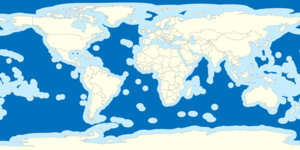International waters facts for kids
International waters are parts of the ocean that do not belong to any single country. Think of them as the "high seas" or the "common heritage of mankind." These areas are usually found more than 200 miles away from any country's coastline. This special distance is set by international rules to make sure every country has fair access to the sea near its shores, while also leaving a huge part of the ocean open for everyone.
Contents
What are International Waters?
International waters are also known as the high seas. They are open to all countries, whether they have a coastline or not. This means that ships from any nation can travel through them freely. No single country has the power to make laws or control what happens in these areas. Instead, countries work together through international agreements to manage activities like shipping, fishing, and scientific research in these shared spaces.
Why are they important?
International waters are super important for many reasons:
- Shipping: Most of the world's trade happens by ships crossing these waters. It's like a global highway for goods.
- Fishing: Many countries fish in these areas to catch seafood. However, there are rules to prevent overfishing and protect marine life.
- Science: Scientists from all over the world study the ocean, its creatures, and its environment in international waters.
- Resources: These areas might also contain valuable resources like oil, gas, or minerals deep under the seabed.
The Law of the Sea
The rules for international waters come from a big agreement called the United Nations Convention on the Law of the Sea (UNCLOS). This agreement was signed in 1982 and helps countries understand their rights and responsibilities in the ocean. It's like a rulebook for the seas.
What UNCLOS does
UNCLOS sets out different zones of the ocean:
- Territorial Sea: This is the area up to 12 miles from a country's coast. The country has full control here, just like on its land.
- Contiguous Zone: This goes from 12 to 24 miles from the coast. A country can enforce laws here, especially to prevent smuggling or pollution.
- Exclusive Economic Zone (EEZ): This extends up to 200 miles from the coast. In this zone, a country has special rights to explore and use the marine resources, like fish and oil. Other countries can still sail through or fly over this area.
- High Seas (International Waters): Everything beyond the EEZ is international waters. Here, all countries have freedom of navigation, fishing, scientific research, and laying cables and pipelines.
Who makes the rules?
Since no single country owns international waters, countries have to cooperate. Organizations like the International Maritime Organization (IMO) create rules for safe shipping and preventing pollution. Other groups work on managing fishing or protecting the environment in these shared areas. It's a big team effort to keep the oceans healthy and safe for everyone.
Images for kids
-
Komárno in Slovakia is an inland port on the Danube River which is an important international waterway.
See also
 In Spanish: Alta mar para niños
In Spanish: Alta mar para niños






